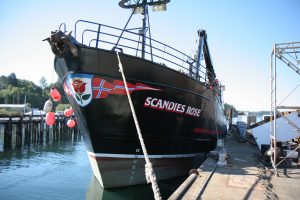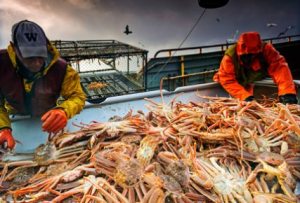206.624.8844
F/V SCANDIES ROSE SINKS in Gulf of Alaska
 On January 31, 2019 at approximately 10 p.m., the F/V SCANDIES ROSE sank near Sutwik Island, Alaska with seven crew members on board. According to a news release by the U.S. Coast Guard, two survivors were rescued and five crew members remain missing from the 130-foot crab fishing vessel. When the Coast Guard arrived at the scene, visibility was almost zero but they were able to see the faint lights of the life raft holding the two rescued crew members. The search for the missing crew members included a span of 1400-square miles with weather reported at the scene of 60 mph winds. The Coast Guard used four MH-60 Jayhawk helicopter crews, two HC-130 Hercules airplane crews, and the Coast Guard Cutter Mellon in an attempt to find the missing crew members. After 20-hours of searching, the U.S. Coast Guard made the difficult decision to suspend the search for the missing crew on January 1, 2020 at 6:08 p.m.
On January 31, 2019 at approximately 10 p.m., the F/V SCANDIES ROSE sank near Sutwik Island, Alaska with seven crew members on board. According to a news release by the U.S. Coast Guard, two survivors were rescued and five crew members remain missing from the 130-foot crab fishing vessel. When the Coast Guard arrived at the scene, visibility was almost zero but they were able to see the faint lights of the life raft holding the two rescued crew members. The search for the missing crew members included a span of 1400-square miles with weather reported at the scene of 60 mph winds. The Coast Guard used four MH-60 Jayhawk helicopter crews, two HC-130 Hercules airplane crews, and the Coast Guard Cutter Mellon in an attempt to find the missing crew members. After 20-hours of searching, the U.S. Coast Guard made the difficult decision to suspend the search for the missing crew on January 1, 2020 at 6:08 p.m.
At the time of the incident, our law firm was involved in pending litigation in King County Superior Court against the vessel for alleged unsafe crab pot stacking practices that led to a career-ending crew injury. The captain of the vessel had recently given a deposition in the crab pot stacking case on December 12, 2019 and some of the other crew members were witnesses in the case. In his deposition, the captain gave extensive testimony about his crab pot stacking practices. Our lawyers and expert boarded the F/V SCANDIES ROSE in Seattle on May 18, 2019 as part of the investigation into the case and inspected the vessel and its equipment. Because the stability of the F/V SCANDIES ROSE in icing conditions may be a substantial issue in the investigation into the sinking, the testimony of the captain and other evidence collected in our case could be important to the investigation and any litigation. Our sincere condolences go out to the families and friends of the missing crew members. By all accounts, they were brave men doing a difficult job and they will be deeply missed by all.
Under the Jones Act, the personal representative of the estate of a seaman lost at sea may bring a cause of action for wrongful death for the benefit of (1) a surviving spouse and children; (2) parents; and (3) dependent next of kin. 45 U.S.C. § 59. Common law spouses may recover, if, looking to applicable state law, the existence of common law marriage is recognized. The recoverable damages for wrongful death under the Jones Act include damages for loss of financial support, loss of nurture and guidance to minor children, loss of service, and pre-death pain and suffering. See e.g., Centeno v. Gulf Fleet Crews, Inc., 798 F.2d 138 (5th Cir. 1987). If you have questions about the remedies available under the Jones Act for wrongful death, feel free to contact our law firm for a free consultation to discuss maritime law remedies under these circumstances. Because of the complexity of these issues and the unique nature of maritime law, it is important that you consult with an experienced maritime injury law attorney.
 Seattle Maritime Injury Lawyer Blog
Seattle Maritime Injury Lawyer Blog


